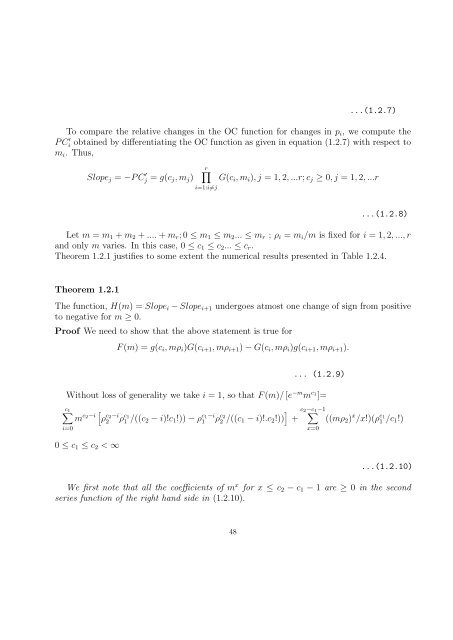Multiattribute acceptance sampling plans - Library(ISI Kolkata ...
Multiattribute acceptance sampling plans - Library(ISI Kolkata ...
Multiattribute acceptance sampling plans - Library(ISI Kolkata ...
You also want an ePaper? Increase the reach of your titles
YUMPU automatically turns print PDFs into web optimized ePapers that Google loves.
...(1.2.7)<br />
To compare the relative changes in the OC function for changes in p i , we compute the<br />
P C ′ i obtained by differentiating the OC function as given in equation (1.2.7) with respect to<br />
m i . Thus,<br />
Slope j = −P C ′ j = g(c j , m j )<br />
r∏<br />
i=1:i≠j<br />
G(c i , m i ), j = 1, 2, ...r; c j ≥ 0, j = 1, 2, ...r<br />
...(1.2.8)<br />
Let m = m 1 + m 2 + .... + m r ; 0 ≤ m 1 ≤ m 2 ... ≤ m r ; ρ i = m i /m is fixed for i = 1, 2, ..., r<br />
and only m varies. In this case, 0 ≤ c 1 ≤ c 2 ... ≤ c r .<br />
Theorem 1.2.1 justifies to some extent the numerical results presented in Table 1.2.4.<br />
Theorem 1.2.1<br />
The function, H(m) = Slope i − Slope i+1 undergoes atmost one change of sign from positive<br />
to negative for m ≥ 0.<br />
Proof We need to show that the above statement is true for<br />
F (m) = g(c i , mρ i )G(c i+1 , mρ i+1 ) − G(c i , mρ i )g(c i+1 , mρ i+1 ).<br />
... (1.2.9)<br />
Without loss of generality we take i = 1, so that F (m)/ [e −m m c 1<br />
]=<br />
c 1 ∑<br />
i=0<br />
m [ c 2−i<br />
ρ c 2−i<br />
2 ρ c 1<br />
1 /((c 2 − i)!c 1 !)) − ρ c 1−i<br />
1 ρ c 2<br />
2 /((c 1 − i)!.c 2 !)) ] c 2 −c ∑ 1 −1<br />
+ ((mρ 2 ) x /x!)(ρ c 1<br />
1 /c 1 !)<br />
0 ≤ c 1 ≤ c 2 < ∞<br />
x=0<br />
...(1.2.10)<br />
We first note that all the coefficients of m x for x ≤ c 2 − c 1 − 1 are ≥ 0 in the second<br />
series function of the right hand side in (1.2.10).<br />
48
















